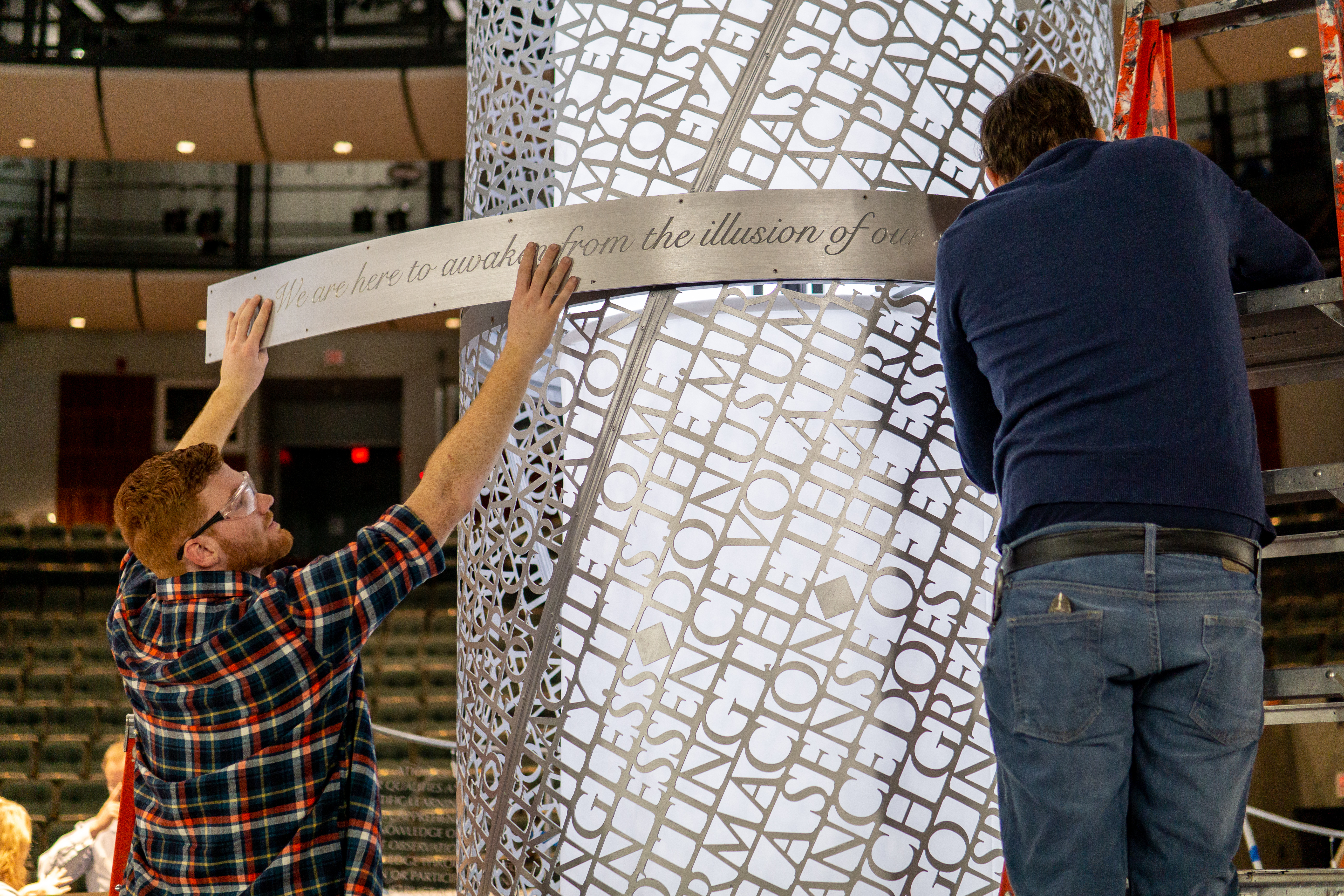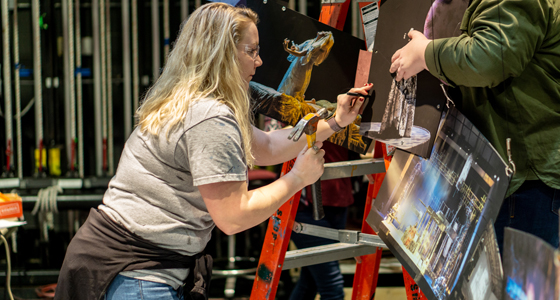In January, members of USITT’s Upstate New York Regional Section were treated to the first public preview of the U.S. installations for the 14th Prague Quadrennial of Performance Design and Space (PQ).
The Section’s annual Frank Willard Winter Session and Job Fair was hosted by the University at Buffalo (UB), the institution chosen by the Institute to build the 2019 installations.
Begun in 1967 as a way to bridge East and West during the Cold War era, the PQ exists to bring the best of design for performance, scenography, and theatre architecture to the front line of cultural activities to be experienced by professional and emerging artists and the general public, according to its website. USITT has sponsored the U.S. exhibit at the PQ for more than 40 years.
In remarks made during a roundtable discussion about the exhibits at the Section meeting, Executive Director David Grindle said that he finds the PQ an amazing gathering because “it really does let you see theatre design from around the world and it prompts the question ‘What does that mean?’ Each nation translates, so to speak, design to represent themselves. Our challenge, in the U.S., is that we are a nation of more than 300 million people. We’re trying to encompass the aesthetic of this massive nation in some format.”
The theme of this exhibition is porous borders. And there are no borders between the countries of the North American exhibit.
“We purposely did that,” said Grindle.
“Think about the other borders that we have that are porous. What are the borders between us? We create borders, artistic ones, emotional ones, relationship borders, that we try to pass through, so, in our nation right now, and in many nations, the idea of geographical borders is the first thing to come to mind. That was one of the first borders that we tried to get rid of as we worked as a multinational partnership.”
 Grindle said that he is also excited that the U.S. exhibits have intentionally sought to show the diversity of theatre design.
Grindle said that he is also excited that the U.S. exhibits have intentionally sought to show the diversity of theatre design.
“Both design teams for these exhibits were led by female designers,” he noted. “That matters because design is still a heavily male-dominated world. We try to feature designers of color, because our nation is diverse, and we wanted to show all those different faces and perspectives. It’s a really exciting way to look at American design this year.”
Jonathan Shimon, an assistant professor in UB’s Department of Theatre and Dance and technical director of the U.S. entry, called being selected the host the build “a huge honor.”
Shimon and Grindle both pointed out that, to their knowledge, this is the first build team to use primarily undergraduate students. Of the nine members of the build team, only one is a master’s candidate. UB does not have a theatre design master’s program.
After the national and emerging design exhibits were finalized last summer, Shimon held an open call for students to be a part of the build team and selected them in the autumn. From then, he said, they started on structural design and began to build on the Monday after Thanksgiving.
Shimon, a self-described “numbers guy,” determined that the nine students, UB colleagues Dyan Burlingame, John Rickus, Eric Burlingame, Rick Haug and himself put in more than 3,450 person-hours between Thanksgiving and mid-January to build the exhibits.
UB Junior Alex Poulin, who is majoring in mechanical engineering with a minor in theatre, acted as a drafter and carpenter for most of the project. He also spent two full days in front of a grinder fashioning intricate conduit to ensure that all of the cables to power the audio and video could successfully snake under the deck of the exhibits.
“One of the most interesting things to me — and one of the structural challenges for me — was figuring out how to weight the bottom of the truss [on the emerging designer exhibit],” said Shimon. “So, that’s what Alex drew. And then we changed it.”
And then it was changed 12 more times, according to designer Dyan Burlingame. “That’s 13 originals that Alex did himself. That’s not stuff that’s coming from the designers. It’s process work where students were figuring it out. There are structural parts of this. I’m a designer and I have no idea how he did 13 versions of those things and I couldn’t tell you how he did it; but what he did was integral.
“Those kinds of revisions and the involvement of the students in that process kept it moving forward. It really speaks to why you need a team of nine students and five faculty to build these two exhibits.”
 In addition to the investment in time made by the UB students, faculty and staff, Shimon noted that he had made 173 purchases for the PQ project, resulting in a total of just over $28,600 spent at local businesses in the Buffalo area.
In addition to the investment in time made by the UB students, faculty and staff, Shimon noted that he had made 173 purchases for the PQ project, resulting in a total of just over $28,600 spent at local businesses in the Buffalo area.
Grindle was quick to point out that of that amount, $25,000 came from a grant from the National Endowment for the Arts.
“We took those federal dollars and poured them directly into the economy of Upstate New York.”
He encouraged those in attendance that “if you get the opportunity to work with the ever-dwindling federal and state funding for the arts, make sure you take the time to account for spending it locally in small businesses because that reminds people that your own tax money is coming back into your own community.”
After the preview at the Regional Section meeting, the exhibits were showcased at a UB alumni association reception before being disassembled and packed for the trip to Louisville, where the exhibits will be on display on the Stage Expo floor during the Annual Conference before being shipped to Prague for the quadrennial exhibition in June 2019.
USITT will tour a scaled-down version of this year’s PQ exhibit until the 15th PQ in 2023.
In addition to the NEA, additional generous support and in-kind contributions for this exhibit came from Figure 53, J.R. Clancy, Rose Brand, Gantom Lighting, ETC, Nicopress, Rosco, Applied Electronics, and others. The Institute is grateful for their support.
UB student members of the PQ Build Team: Gina Boccolucci, Joe Crumlish, Katherine Metzler, Alex Poulin, Emily Powrie, Aliza Schneider, Becca Stock, Madison Sullivan, and Luke Tarnow-Bulatowicz.
